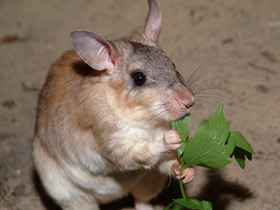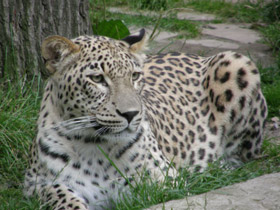Domestic goat Capra hircus
The domestic goat was probably among the earliest domesticated animals: goat was likely domesticated around 9,500 years ago in the territory of Iran. Domestic goats, Capra hircus, are thought to descend from the bezoar goat Capra aegagrus and the markhor Capra falconeri. Being generalists, grazing and browsing in a variety of habitats, goats are able to find food in most inaccessible places (goats can even climb trees) and it is not surprising that these animals are abundant all over the world. Goats are reputed to be willing to eat almost anything, and can survive on extremely poor-quality forage, in the habitats where no other ungulate would survive. Goats easily withstand extreme cold and heat but they are not adapted to humid climate. Goat overgrazing can cause erosion and disappearance of natural vegetation; domestic and feral goats almost completely destroyed natural vegetation in Mediterranean countries, large part of Africa, Western and Central Asia, and many oceanic islands.
There are not so many breeds of domestic goats. Their sizes, and the colour and structure of the fur are highly diverse. For instance, the fur of the Angora goat is long and silky, while the Cashmere goat is famous for its dense, downy undercoat. The goat fur may have most different colours, from dazzling white to dark brown, black, and motley. Sheep are multi-purpose animals, raised for their meat, milk, wool, hides, and skins. The total world population of domestic goats is estimated at half a billion individuals, with half of them being found in Asia, and one third living in Africa.
The pygmy goat, originally called the Cameroon dwarf goat
The pygmy goat, originally called the Cameroon dwarf goat, was bred in Equatorial Africa. The Cameroon goats were first noticed by the seafarers because these miniture goats did not occupy much space in the ships but served as an excellent source of milk and meat. In the late 19th century, the Cameroon dwarf goats were exported from Africa to zoos in Sweden and Germany where they were on display as exotic animals.From there they were distributed all over the world. The pygmy goats are quite hardy and can adapt to virtually all climatic conditions, easily withstanding both severe cold and hot weather. The pygmy goat is one of the smallest goats with shoulder height ranging from 41 to 58 cm and weight of 23 to 39 kg.
Pygmy Goats have a natural ability to jump and climb trees and they are sometimes called African tree goats. Pygmy goats are agile, gentle, loving creatures which can easily learn various tricks. Small horns are slightly curved backward and can not inflict serious injury, which feature makes these animals very popular inhabitants of petting zoos. This breed is considered to be the source of meat and milk. In the peak of lactation the does can produce up to 2.5 litres a day with fat content of 4.5 to 11%. Although the yield is not very high, the milk of pygmy goats is perfect for home cheese making. Raw milk maintains its freshness and flavor in refrigerator for two weeks. Milk of pygmy goats is richer in calcium, phosphate, potassium, and iron, and contains less calcium than the milk of common goats; besides, it has a very nice flavor and does not have a characteristic “goaty smell”.
A pygmy goat doe gives birth to 1 to 4 kids which are able to stand and suck milk as soon as in two minutes after birth. The kids start running and jumping in four hours. The lifespan of the Cameroon dwarf goat is estimated at 10 to 15 years.
Saanen goat
The Saanen goat is named after the Saanen valley in Switzerland where selective breeding of dairy goats has taken place for several hundred years. In 19th century, these goats attracted attention of an official who was visiting Swiss valleys on business. The news about beautiful dairy goats with calm and placid personality was circulated around the world. By the late 19th century, several thousand Saanen goats had spread across Europe, and were also brought to the United States and Australia. In the early 20th century, Saanen goats were imported in Russia. Due to the rich alpine pastures and mountain climate of the Alps, Swiss farmers managed to breed one of the largest dairy goats, capable of high yields (this breed can typically yield 9 litres of milk and good care and appropriate feeding may provide a yield of 1,000 to 1,200 litres of milk per year). Saanen goat is one of the largest goats of diary breeds; females, called does, typically weigh 45 to 55 kg and stand 75-76 cm tall at the shoulder, with bucks weighing from 75 to 77 and standing 82 to 85 cm tall.




















































